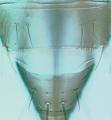Thrips maculicollis
Recognition data
Distinguishing features
.Female brown, tarsi and tibiae yellow with brown shadings; antennal segment III yellow; fore wings pale in basal quarter, then brown but slightly paler to apex. Antennae 8-segmented; ocellar setae III arise outside ocellar triangle; postocular setae II about half as long as seta I. Pronotum broad with weak transverse markings, discal setae relatively small. Mesonotum transversely striate on posterior half, no lines close to anterior campaniform sensilla. Metanotum reticulate medially, median setae arise at anterior margin, campaniform sensilla present. Fore wing first vein with 7 setae basally and 3 widely spaced setae on distal half, clavus with subapical seta longer than the apical seta. Abdominal tergite II with 4 lateral setae; tergite I covered with lines of sculpture, II–VIII with no lines of sculpture extending mesad to campaniform sensilla; tergite VIII comb with a few teeth laterally; tergite X as long as VIII; sternite II with 4 discal setae, III–VII with 12–16 discal setae; pleurotergites without discal setae. Male yellow, antennal segments IV–VIII brown, wings slightly shaded, sternites III–VII with large transverse pore plate.
Related and similar species
The genus Thrips is the second largest genus in the Thysanoptera, and currently includes, worldwide, about 285 species. T. maculicollis has been taken in quarantine at California, and is presumably a native of some unknown Pacific territory. It is closely related to another species from the Pacific, T. longicaudatus, and is a member of the T. hawaiiensis species-group (Mound & Masumoto, 2005). All members of genus Thrips lack ocellar setae I on the head, and they all have ctenidia on tergite VIII posteromesad to the spiracles. Other characters, such as number of antennal segments, number of setae on the fore wing veins, and number of discal setae on the sternites are variable between species (Palmer, 1992; Nakahara, 1994; Mound & Masumoto, 2005).
Taxonomic data
Current valid name
- Thrips maculicollis (Hood)
Original name and synonyms
- Physothrips maculicollis Hood, 1918: 122
- Lefroyothrips maculicollis (Hood); Bhatti, 1978: XX
Family placement
Thripidae, Thripinae
Biological data
Life history
Breeding in flowers.
Host plants
In New Caledonia taken inflowers of Fagraea schlechteri (Loganiaceae) and an unidentifed Apocynaceae; intercepted from Hawaii in quarantine at California in flowers of Fagraea berteriana.
Tospoviruses vectored
None
Crop damage
None
Distribution data
Area of origin
Probably western Pacific, but described originally from northern Australia
Distribution
Australia, New Caledonia; intercepted in quarantine at California from Hawaii.



